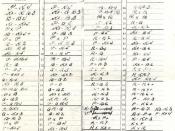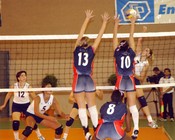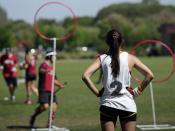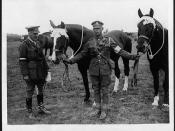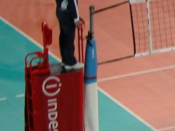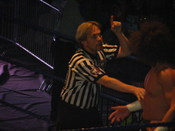Officiating is a very important part in any sport. A team of officials performs officiating. The team consists of a first referee, a second referee, a scorekeeper, and two or four line judges. Each official has their own responsibilities or shares responsibilities with another official. The entire official team should an assigned uniform and have the appropriate equipment. The uniform assigned to wear is white certified volleyball official polo shirt, dark navy blue pants, blue or black belt, white socks, and solid white shoes. They also must be well groomed and neat in appearance. The equipment needed to an official is a whistle with lanyard, watch with second hand or timer, yellow and red card, coin, Rule Book, net height measuring device, and ball pressure gauge and pump. An effective officiating team is one in which each official does the job well and is alert to being able to assist and support the other officials.
The First Referee is called the head official. They are in full control of the match and any judgment decisions made by the first referee are final. This referee is located at one end of the net, standing or sitting on the referee's stand. Their eyes should be 50 cm above the top of the net. The first referee has authority over all player and officials from the coin toss prior to the first game of a match until the conclusion of the match. Also, have the authority to overrule other officials is she/he is certain one of the officials made an incorrect decision. Another authority they have is they can replace an official who is not performing functions properly. The first referee has many responsibilities to accomplish prior to the game. These responsibilities consist of inspecting and approving the playing area such as net, balls, and other equipment, establishing ground rules for the playing space alone, performing the coin toss and conducting the conference with the team captains, controlling the warm-ups of the teams, and determining whether conditions meet plating requirements. The first referee also has responsibilities to follow during the match. These responsibilities are banning misconduct and delays, deciding upon faults of the server and of the positions of the serving team, and deciding faults in playing the ball. These are the reason why the First referee is the most important.
The Second Referee is the assistant to the first referee with his/her own responsibilities. This referee is located standing near the post outside the playing court opposite and facing the first referee. The authority that the second referee has is they may, without whistling, signal faults to the first referee, but may not insist on them, work in conjunction with the scorekeeper, and supervises the team members on each bench and report any misconduct to the first referee. Also, they authorize game interruptions; control the number of time-outs and substitutions used by each team, and checks the floor conditions. Prior the game, their responsibilities consist of attending the meeting of the team captains with the first referee, and checks that the players are in the correct position corresponding to the line-up sheet. During the match, the second referee responsibilities are whistling or signaling position faults of the receiving team, the contact of a player with net or the antenna, going under the net, the attack-hit or clocking faults of the back-row player, when a ball crosses the net outside the crossing space or touches the antenna, and when a ball contacts an outside that is out of play.
The scorekeeper is the next official I will talk about. The scorekeeper is located on the side of the court opposite the first referee and behind the second referee, sitting at the score table. The scorekeeper controls the scoresheet and works together with the second referee. The responsibilities that the scorekeeper performs prior to the game are registers the data of the match and teams. Which consists of recording the players' number in serving order from the line-up sheet. The responsibilities during the match are recording points scored and ensuring that the visual score is correct, controls the serving order of each team, recording the time-outs for each team, checking the legality of substitutions before authorizing entry into the game, and signals the referees the ends of the games. At the end of the match, scorekeepers must review the scoresheet and records the final result, verifies the results of the game by signing the scoresheet, and finally in case of a disagreement permits the team captain to write on the scoresheet a statement of the incident.
The final two officials in a volleyball match are line judges. There can be two-line judge or four-line judge depending on what the first referee wants. If there are only two line judges are used, they stand at opposite corners of the court, one to the right of the first referee and one to the right of the second referee. Each line judge controls an end line and a sideline. If four line judges are used, they stand in the free zone at 1m to 3m from each corner of the court, on the imaginary extension of the line they control. The end line is controlled from left service corner and the sidelines from the opposite corner. The line judges make their calls by using two hands or single flag. The line judge responsibilities consist of signaling the ball "in" and "out" whenever the ball lands near their lines, signals touches of "out" balls, and signal foot faults of players who are off the court at the time of service. Also, the line judges in charge of the end lines signal foot faults of the servers. The line judge has the least responsibilities and is not very important.
To conclude, officiating is a very important to any sport played. In volleyball there is a team of officials. The team consists of first referee, second referee, scorekeeper, and two or four line judges. Each official has his or her own responsibilities to perform during the match. Also, they have special hand signals for each call. As of right now there are twenty-seven official hand signals that the officials use.
References Kluka, Darlene. Winning Edge Series Volleyball Fourth Edition. New York: McGraw-Hill Companies, 2000.
Lenberg, Kinda. 2000-2001 Official United States Volleyball Rules. Colorado Springs: USA Volleyball, 2000.
Polvino, Geri. NADWS VOLLEYBALL RULES. Columbus: Sports Imports, 1986.
